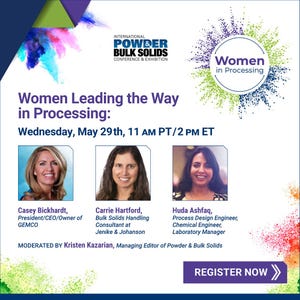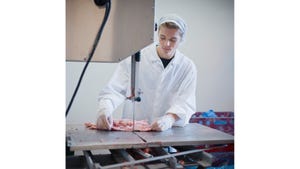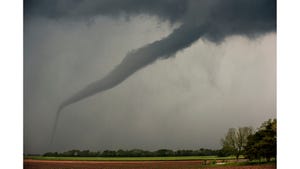GEA Niro Collaborating with DTU to Build Better Spray Dryer
August 4, 2011
GEA Niro is working hand-in-hand with the Technical University of Denmark (DTU), to simulate the fluid dynamics that take place within a full-sized spray dryer. This is done using a scaled down model with water instead of air. The process allows experiments to be performed at a laboratory level that would otherwise require full-scale equipment of several meters in all dimensions. The data gathered helps GEA Niro refine the development of its spray drying equipment and ensures that its technology keeps pace with, and sometimes drives, its customers’ production needs.
The laboratory equipment, financed by GEA Niro, is impressive. Inside the scaled-down clear polycarbonate spray dryer containing swirling water thousands of microscopic particles are turned alive by two green flashes from a laser. Meanwhile a powerful computer shows a picture full of arrows, in different shapes and sizes, indicating the speed and direction of the flow.
"We let the water run through the container and then create vertically aligned laser light," explained associate professor Knud Erik Meyer, DTU Mechanics. "We shoot twice in a row and record each laser pulse. As the particles in the water move from the first to the second picture we can see how fast and in which direction the particles move."
Thorvald Ullum, Fluid Mechanics Manager at GEA Niro, has been working on the development of spray dryers primarily used for powder production in food, chemical, and pharmaceutical products for many years. "This research collaboration makes it possible for GEA Niro to optimize our systems to be as compact and energy efficient as possible. At the same time, it makes it possible to improve the drying process, allowing the systems to produce better products by controlling the temperature of the particles during the drying process," he says. "Today, we dedicate resources to understand, in detail, what happens locally in the different parts of the spray dryer. We can now make computer simulations of the spray drying process very accurately. By using CFD (Computational Fluid Dynamics) we can predict how the air moves and thereby how the particles dry. It is essential to know how close the simulations are to reality. How much can we trust our computer simulations? In truth the simulations are only part of the evaluation process. Although the simulation results are very accurate, every assumption has to be tested and validated on production equipment."
Using water rather than air allows the experiments to be performed on a smaller scale. "When one uses streaming water, it equals simulating the flow of air at the same Reynolds number* but in a container fifteen times bigger. It is simply possible to make the setup smaller when you use water," explained Knud Erik Meyer. It’s in the basement laboratory at DTU Mechanics that the arrows on the computer screen are thoroughly analyzed. "We definitely have a jet stream that shoots downwards and centrally in the spray dryer," explained Jonas Hansen, who is one of the many DTU students performing advanced flow-analyses as part of the collaboration with GEA Niro, under the supervision of Knud Erik Meyer.
Turbulence is a known problem in fluid dynamics and has to be taken into account when performing CFD calculations. It makes the flow pattern complicated and it would take too much computing power to predict the flow accurately without some simplifications. Therefore the system uses commercially available turbulence models, and different models are used depending on the flow conditions. Precisely which flow model is used for each experiment is strictly confidential and is the reason GEA Niro retains its competitive edge and technologically leading position.
The aim is to get as complete a picture as possible of the turbulent flow pattern in a spray dryer for as many different case scenarios as GEA Niro finds relevant. The recorded experimental flow patterns are then compared with theoretical flow patterns from computer simulations. The results from DTU’s experiments will help Thorvald Ullum and his colleagues to choose the right turbulence model for their CFD simulations to further refine the drying processes in newly developed spray dryers. Taking the simulations one step further is exactly what is required for GEA Niro to maintain the technological lead and, according to Thorvald, to keep building the best drying systems on the market. "DTU has the most advanced equipment, and the researchers at DTU have the knowhow we need," he said.
In an intensely competitive market, one in which innovation is the driving force for continued success, the collaboration with DTU is an important part in maintaining a leading position for GEA Niro today and in the future.
For more information, visit www.niro.com.
You May Also Like


